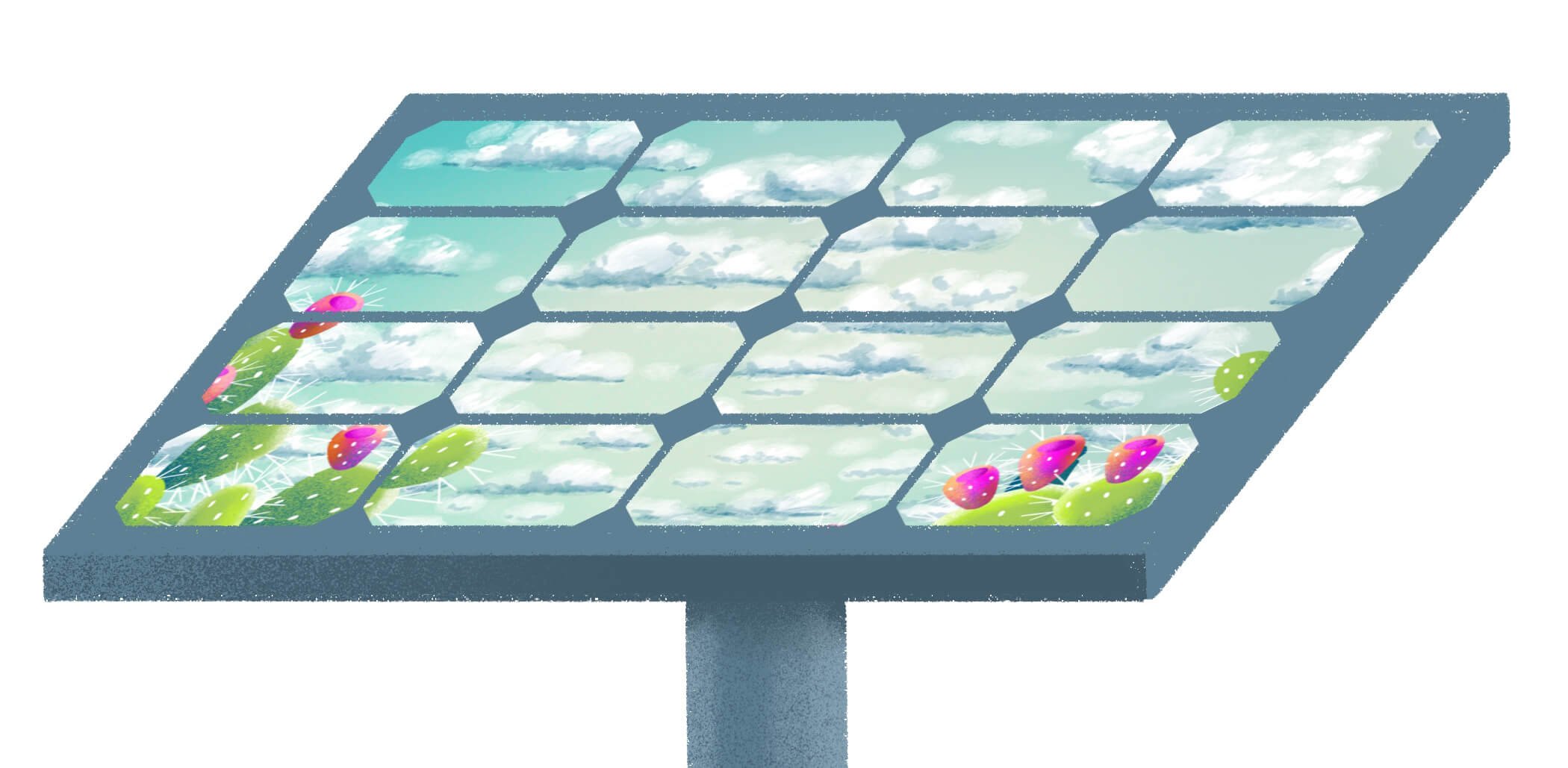Charging Ahead
By Marc Airhart. Illustrations by Jenna Luecke.
From the economy to the environment, from public health to national security, the energy options available to us help shape our lives. Fortunately, chemists and physicists, in collaboration with engineers and others, are making steady progress on developing new materials that may prove key for our future energy needs. These faculty and their fellow researchers at The University of Texas at Austin are laying the scientific groundwork for clean, abundant energy for our children’s children. They are working now on boosting the power in solar cells, developing cleaner battery technology and reducing greenhouse gases using novel technologies like a synthetic fuel.
Amping Up Solar Cells
Conventional silicon solar cells are inefficient, converting about a quarter of the energy from sunlight into electricity. If that conversion rate were better, manufacturers could squeeze more energy from smaller solar panels and make solar power even more affordable.
Feliciano Giustino, a quantum physicist, is exploring a group of compounds called perovskites that have the potential to boost efficiency if layered onto a silicon solar cell. He has developed advanced computer simulations based on basic principles of physics, and now used by hundreds of scientists around the world, to design new materials at the atomic scale. The supercomputing resources at UT’s Texas Advanced Computing Center have greatly accelerated his research.
“We simulate the arrival of a light beam and then basically make the material respond to it at the quantum mechanical level and see what comes out,” said Giustino, professor in the Department of Physics and Moncrief Chair in the Oden Institute for Computational Sciences and Engineering.
Perovskites rival silicon for efficiency, but the first ones discovered weren’t very stable and tended to release lead, an environmental hazard. In 2016, Giustino and his collaborators discovered a new class of lead-free perovskites, one of which is stable and currently being tested for possible use in solar cells.
Giustino has developed advanced computer simulations, now used by hundreds of scientists around the world, to design new materials at the atomic scale.
Meanwhile, chemists Sean Roberts and Michael Rose are exploring another class of materials that could be layered on top of solar cells to boost efficiency. About half of the energy that conventional solar cells lose is due to heat generation within the silicon.
“The goal of our project is to claw back some of this energy loss by chemically attaching organic dyes to the surface of the silicon cell that reduce heat losses and convert more of that energy into electricity,” said Roberts, the project’s principal investigator and an associate professor of chemistry.
A new electron microscope in the Sauer Structural Biology Laboratory is enabling the team to use a technique called microcrystal electron diffraction (MicroED), which is good at analyzing very small crystals, to see exactly how small collections of molecules in the coating are located and oriented. The fact that the organic layer is grown on a silicon substrate means the molecules will pack differently than on another substrate.
“So I had the idea that if microED can be used on samples that are so thin, maybe it could also be used on these thin films that we grow to resolve the actual atomic structures,” said Gabriella Ruiz, a graduate student in Rose’s lab spearheading the technology’s application to the solar cell project.
The technology will help guide the team to better material designs and improved manufacturing processes.
Cleaner, Cheaper Batteries
The modern lithium-ion battery that powers the world’s cellphones, laptops and electric cars was co-invented by UT Austin’s Nobel Prize-winning mechanical engineer John Goodenough, the Virginia H. Cockrell Centennial Chair. But the battery has drawbacks: mining the lithium and cobalt used in it has significant impacts on the environment and human health. And these elements can add a hefty price tag to large- scale applications, such as smoothing out the ebb and flow of wind and solar energy on electric grids.
Graeme Henkelman is a theoretical chemist who uses computer simulations to study why materials behave the way they do and to design new materials. He is collaborating with engineering professor David Mitlin to develop better sodium batteries, a type of battery that replaces the lithium and cobalt in traditional lithium-ion batteries with cheaper, more environmentally friendly sodium.
Unfortunately, with sodium batteries, a component called the anode tends to grow needle-like filaments called dendrites that can eventually cause the battery to electrically short – and even catch fire or explode. The UT team’s new sodium metal anode solves the dendrite problem and enables recharging as quickly as a traditional lithium-ion battery. The key is a unique fabrication method of rolling and folding two materials together, like a layered pastry, to produce a composite with a very uniform distribution of sodium atoms.
“This material is also exciting because the sodium metal anode theoretically has the highest energy density of any sodium anode,” said Henkelman, Watt Centennial professor of chemistry and a member of the Oden Institute.
Meanwhile, chemist Michael Aubrey is searching for suitable materials that replace lithium with another alternative: magnesium. One challenge is that magnesium-based electrodes tend to quickly build up oxide layers on their surfaces that reduce the flow of electricity. So far, batteries with magnesium- based electrodes can only be charged and discharged about 100 cycles before they no longer function.
“If you’re building a large, grid-level storage system, you’re going to want to use it more than a few dozen times. You’re probably going to want to use it 10,000 times,” Aubrey said.
Aubrey and his team use synthetic chemistry to design and build materials that don’t exist in nature and test them in various ways such as X-ray diffraction to determine the crystalline structure. They also create prototype batteries and measure their electrochemical properties.
“We would like to at least answer the question of whether it’s actually possible to make lower cost batteries that are competitive with established technologies using our alternative materials over the next few years,” Aubrey said.
Chemists are pursuing an economically viable path to reduce greenhouse gas emissions and turn waste into fuel.
Greenhouse Gas to Green Fuel
Drive though the West Texas oil patch or near chemical plants along the Gulf Coast and you might see tall pipes piercing the sky like lit candles, flaring excess natural gas. And it’s not just in Texas. The gas is too expensive to liquify and transport, so at sites around the world, it’s often vented or burned. But in a warming world, that just adds more heat- trapping methane and CO2 to the atmosphere.
Chemist Simon Humphrey is developing affordable catalysts for turning this methane gas into methanol, which can be mixed with diesel fuel to power farming equipment or for other uses. If it works, it will provide an economically viable path to reduce greenhouse gas emissions and turn waste into fuel. Chemists already know how to do this, but existing catalysts use precious metals like palladium or platinum, making them too expensive for this application.
On the Periodic Table, precious metals are in a kind of Goldilocks zone of reactivity that make them ideal for catalysts: elements to the left are too reactive and elements to the right are too stable. Humphrey and Henkelman are developing a kind of poor man’s version of precious metals by combining two different metals into composite nanoparticles.
“We’re using the unique technology that we’ve developed to basically blend two elements on either side to make a synthetic version of a metal which is in that Goldilocks zone,” Humphrey said. “We’re basically cheating the system to make it behave like platinum or palladium.”
To get these particular pairs of elements, for example ruthenium and copper, to make an alloy can be incredibly difficult. But Humphrey and his team arrived at an effective strategy: using a lab-grade microwave oven to create nanosized regions of high heat that nucleate nanoparticle alloys.
“We’re taking what is usually a downside to microwave ovens – that your microwaved burrito has really hot spots and really cool spots – and using it to our advantage,” Humphrey said.
Working with oilfield companies, Humphrey now aims to scale up these more affordable catalysts from the lab to the real world. His colleagues in the physical sciences at UT Austin meanwhile are also continuing their efforts to move from promising basic research results to real-world, applied outcomes. If one or all of them succeed, it could prove game-changing for the nation’s and the world’s energy prospects – and that, in turn, would bode well for human health, peace and prosperity, leaving a brighter future for the planet.




